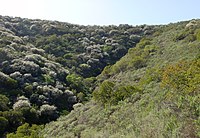
Photo from wikipedia
Abstract As the proportion of the human population living in cities continues to increase, understanding the factors affecting urban biodiversity is crucial to enhancing conservation efforts, urban ecosystem function, and… Click to show full abstract
Abstract As the proportion of the human population living in cities continues to increase, understanding the factors affecting urban biodiversity is crucial to enhancing conservation efforts, urban ecosystem function, and human wellbeing. Here we present the results of the first comparative study of belowground invertebrate communities in urban soils (lawns and biofilters) and remnant patches of native coastal sage scrub (CSS) in a semi-arid urban environment. Among 12 sites sampled in La Jolla, California, USA, invertebrate community composition was most homogeneous among lawns, which differed significantly in composition from both biofilters and CSS. In almost all other aspects of invertebrate community diversity metrics (richness, evenness, diversity) as well as environmental factors (moisture, organic matter, plant cover and richness), lawns differed significantly from native CSS habitats, but biofilters were intermediate and not significantly different from other habitat types. Lawn soil invertebrate evenness and diversity were significantly lower, but density was highest in lawns, with higher densities of oligochaetes (Megadrilacea, Enchytraeidae), fly larvae (Sciaridae, Chironomidae), mites (Oribatida, Mesostigmata), and springtails (Poduromorpha, Symphypleona) in lawns relative to CSS. Differences in soil moisture, organic matter, and plant, tree, and building cover explained 40–62% of the variability in invertebrate density, richness, diversity, and evenness among sites. These findings suggest a shift in belowground invertebrate community structure that may be common among urbanizing semi-arid environments. The amendment of urban dryland soils with organic matter and moisture alters the presence and population density of several invertebrate taxa, and may cause a transition toward dominance by desiccation-intolerant litter transformers.
Journal Title: Landscape and Urban Planning
Year Published: 2019
Link to full text (if available)
Share on Social Media: Sign Up to like & get
recommendations!